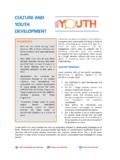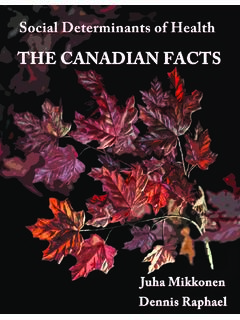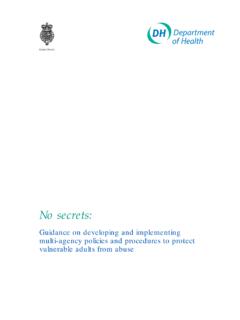Transcription of fact sheet juvenile justice Final - United Nations
1 Fact sheet on juvenile justice Youth are disproportionately represented in statistics on crime and violence, both as victims and as perpetrators, and in many developed countries violent crimes are being committed at younger ages than in the past. Moreover, there is growing concern that, in some countries, the proportion of violent crimes committed by youth has been increasing (UNODC & World Bank, 2007, p. 61). Statistical data in many countries show that delinquency is largely a group phenomenon. Between two-thirds and three-quarters of all offences committed by young people are committed by members of gangs or groups, which can vary from highly structured criminal organizations to less structured street gangs.
2 Even those young people who commit offences alone are likely to be associated with groups. Though poverty and unemployment are not, by themselves causes of violence, they become important factors when coupled with other triggers such as lack of opportunity, inequality, exclusion , the availability of drugs and firearms, and a breakdown in access to various forms of capital, justice and education. While adolescence can be an age of breaking rules evidence shows that most first- time offenders do not reoffend, and that diversion and other community-based measures are the best responses to offences committed by young people. Incarceration, including pre-trial detention, is still used frequently including for young people having committed very minor crimes (such as using drugs, or stealing basic commodities).
3 Crime committed by young people is mainly an urban phenomenon. Evidence shows that the probability of being a victim of crime and violence is substantially higher in urban areas than in rural areas. Over the years, the United Nations has reaffirmed and expanded its mandate to strengthen juvenile justice through the adoption of the World Programme of Action for Youth (WPAY) ( United Nations , 1995) and the work of OHCHR, UNICEF, the Office on Drugs and Crime (UNODC), and the Interagency Panel on juvenile justice (IPJJ). juvenile justice : an introduction Youth, defined by the United Nations as between 15 and 24 years of age, are rising to the forefront of the international agenda.
4 On the one hand, they are formidable assets in innovation and creativity, able to promote equality and justice in society. They often participate in civic life through volunteerism, community service and participation in youth organizations. In some countries, they serve as members of youth committees in local governments helping to shape and influence youth-related policy. On the other hand, however, they are often involved in outbursts of violence and crime, both as perpetrators and victims. Partially this is also due to the fact that in many countries young people represent a large proportion of the population, and accumulate risk factors. Violence and insecurity perpetrated by and against young people are caused by various factors that work simultaneously to create situations of social instability.
5 These factors can include the availability of firearms, the abuse of alcohol, large-scale migration to urban areas and overpopulation, drug trafficking, weak educational and policing systems, unequal distribution of wealth, and the frustration of many young people faced with unemployment and socio-political exclusion . In combination, these elements fuel hopelessness and frustration not only among the youngest segment of the population, but within families, communities and society more broadly. In many households, the tension fuelled by social exclusion and financial hardship has is vented on the most vulnerable members of the family, such as women and children.
6 A. report of the United Nations Office on Drugs and Crime and World Bank (UNODC &. World Bank, 2007) states evidence suggests that children who witness domestic violence are more likely to engage in delinquent and violent behavior in the future . (Smith and Thornberry, 1995; Margolin, 1998). Being subject to violence as a child, is also associated with a higher probability that children and young people will engage in delinquent and violent behavior, as well as increased risk of children and youth abandoning the home and joining their peers on the street. Young people turn to and approach violence in different ways. In restrictive societies, when they see their rights trampled and their civic participation put at risk, they may become involved in revolts and riots.
7 Moreover, in conditions of poverty and unemployment, many young people find in petty crimes, such as pick pocketing and minor fraud, or illegal trafficking a means to secure extra income for themselves or even their families. They are often pressured into such activities by other individuals, such as major criminals, under threat to their person and relatives. However, because of socio- economic constraints and exclusion , some choose a criminal and/or gang life on their own accord, as they find in crime the means to obtain quick cash and alluring commodities as well as social status. juvenile delinquency and violence are of concern to both developed and developing countries.
8 They can be perpetrated by single individuals or by young people acting in groups. Furthermore, they can emerge as occasional expressions of anger and frustration, such as via protests or revolts, or as regular occurrences in everyday life. juvenile justice : a data overview Reports show that in recent years, manifestations of discontent by youth have become increasingly violent (UN-HABITAT, 2006, p. 146). Not only is the proportion of violent crimes committed by young people on the rise, but youth are also increasingly likely to be victims of violent crimes, as research in the Caribbean reveals (UNODC & World Bank, 2007). In addition, there seems to be a link between excessively high urban growth rates and violence in cities (Worldwatch Institute, 2005), with violence becoming an increasingly urban phenomenon.
9 In the urban context, violence is acquiring more visibility than in the past, with much of it carried out on the streets, often in densely populated neighbourhoods. In many urban areas, migration has led to overpopulation and to the consequent formation of slums, off-limits areas and no man's lands, in which even security forces fear to enter. According to estimates in 2005, one out of every three city dwellers nearly one billion people lived in slum conditions. Slums, characterized by social exclusion and lack of social support systems, are distinctive of developing countries;. sub-Saharan Africa is the region with the highest percentage of its urban population living in slums ( ), followed by Southern Asia ( ), Eastern Asia ( ) and Latin America and the Caribbean ( ) (UN-HABITAT, 2006).
10 Street and gang activity among youth Young people roaming the streets have become a normal presence in many urban areas of the developing world, especially in those cities characterized by slums. Estimates suggest that tens of millions of children and youth live or work on the street (UNICEF, 2012, p. 32), and that the majority of them reside in the most populous cities of sub- Saharan Africa, Latin America and India. Either because their families are incapable of supporting them or because they have little choice but to opt for street life over the hardship of their domestic situation, youth in many developing countries have made their home on the street.

















